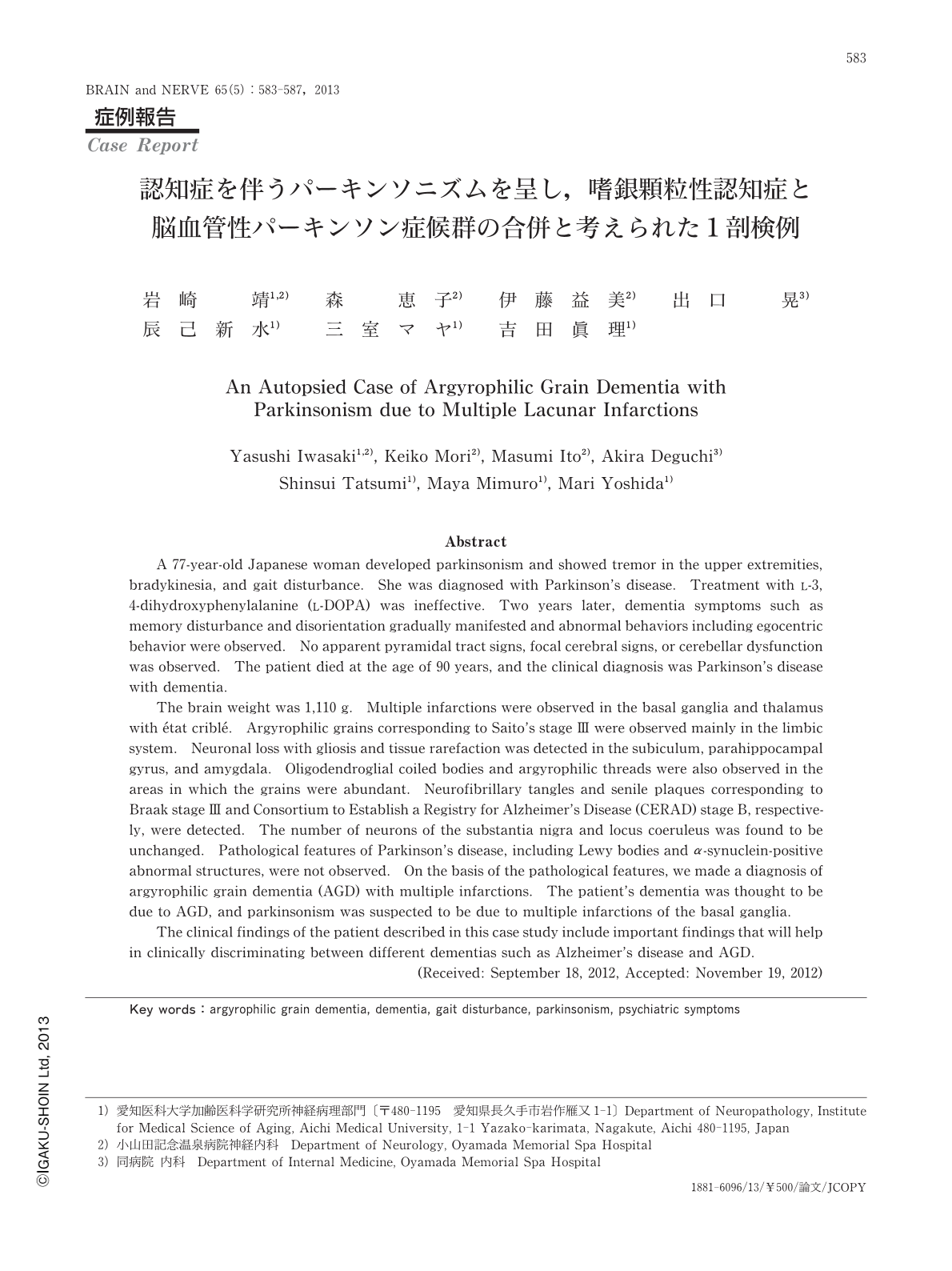Japanese
English
- 有料閲覧
- Abstract 文献概要
- 1ページ目 Look Inside
- 参考文献 Reference
はじめに
嗜銀顆粒性認知症(argyrophilic grain dementia)はBraakら1-3)により記載された老年期の認知症性疾患である。神経変性症性認知症疾患の中ではアルツハイマー型認知症に次ぐ頻度であるが2-4),診断には病理学的検索が必須であるため臨床所見や経過を詳細に検討できる症例は少ない5-7)。ほとんどの症例は臨床的にアルツハイマー型認知症や前頭側頭型認知症,脳血管性認知症と誤診断されている5-7)。また,認知症を呈する種々の神経変性疾患において嗜銀顆粒をしばしば認めるため,嗜銀顆粒の存在と臨床症候との関連性の評価が困難な症例も多い5,6)。
筆者らはパーキンソニズムで発症し,経過中に精神症状を主体とした認知症を呈したため,臨床的に認知症を伴うパーキンソン病と診断されたものの,病理学的検索により嗜銀顆粒性認知症と脳血管性パーキンソン症候群の合併と考えられた高齢女性例を経験したので報告する。
Abstract
A 77-year-old Japanese woman developed parkinsonism and showed tremor in the upper extremities, bradykinesia, and gait disturbance. She was diagnosed with Parkinson's disease. Treatment with L-3,4-dihydroxyphenylalanine (L-DOPA) was ineffective. Two years later, dementia symptoms such as memory disturbance and disorientation gradually manifested and abnormal behaviors including egocentric behavior were observed. No apparent pyramidal tract signs, focal cerebral signs, or cerebellar dysfunction was observed. The patient died at the age of 90 years, and the clinical diagnosis was Parkinson's disease with dementia.
The brain weight was 1,110 g. Multiple infarctions were observed in the basal ganglia and thalamus with état criblé. Argyrophilic grains corresponding to Saito's stage III were observed mainly in the limbic system. Neuronal loss with gliosis and tissue rarefaction was detected in the subiculum, parahippocampal gyrus, and amygdala. Oligodendroglial coiled bodies and argyrophilic threads were also observed in the areas in which the grains were abundant. Neurofibrillary tangles and senile plaques corresponding to Braak stage III and Consortium to Establish a Registry for Alzheimer's Disease (CERAD) stage B, respectively, were detected. The number of neurons of the substantia nigra and locus coeruleus was found to be unchanged. Pathological features of Parkinson's disease, including Lewy bodies and α-synuclein-positive abnormal structures, were not observed. On the basis of the pathological features, we made a diagnosis of argyrophilic grain dementia (AGD) with multiple infarctions. The patient's dementia was thought to be due to AGD, and parkinsonism was suspected to be due to multiple infarctions of the basal ganglia.
The clinical findings of the patient described in this case study include important findings that will help in clinically discriminating between different dementias such as Alzheimer's disease and AGD.
(Received: September 18, 2012, Accepted: November 19, 2012)

Copyright © 2013, Igaku-Shoin Ltd. All rights reserved.


